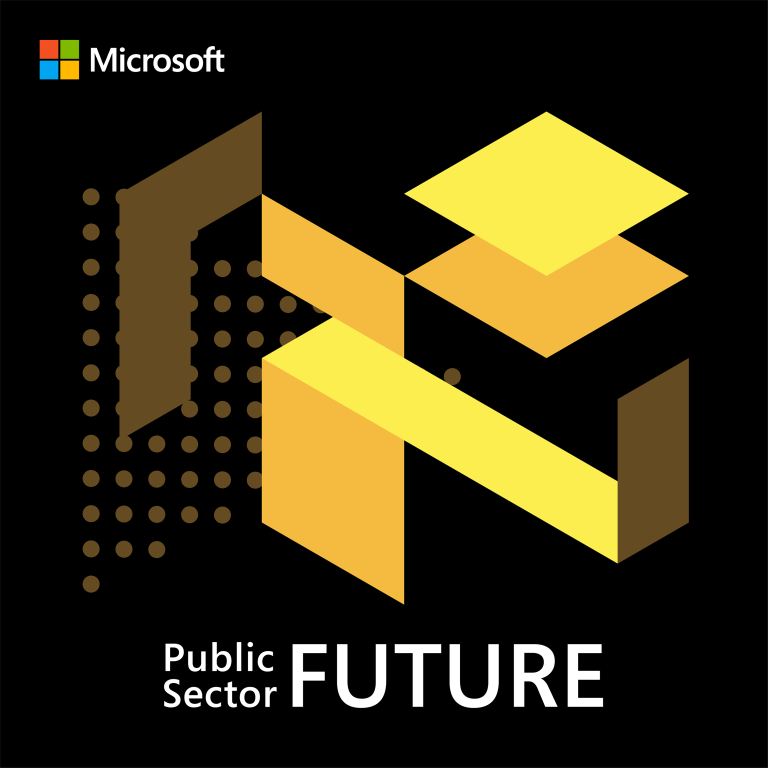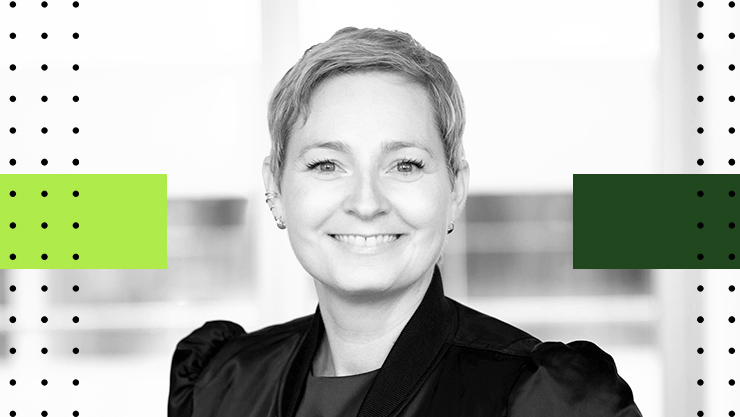
How to build a digital organization at scale
with Jacky WrightJacky Wright spent two years on secondment to Her Majesty’s Revenue and Customs (HMRC), the UK’s tax and customs department, where she was their Chief Digital and Information Officer. In 2019, she rejoined Microsoft as Chief Digital Officer and Corporate Vice President.

This is a show for anyone who cares about using digital approaches in the public sector to deliver better outcomes. We explore stories from around the world, where public servants have been successful at driving change. We meet the people behind the stories, to hear their first-hand experiences and lessons learned. Throughout the series we discuss technology and trends, as well as the cultural aspects of making change happen.
In this episode we discuss Jacky Wright’s experience as the Chief Digital and Information Officer of Her Majesty’s Revenue and Customs (HMRC), the UK’s tax and customs department. She shares how to build a digital organization at scale and how to create an inclusive culture to deliver the best outcomes. Wright has held leadership roles in both the public and private sector and rejoined Microsoft in 2019 as the Chief Digital Officer and Corporate Vice President.
Click here for transcript of this episode.
Her Majesty’s Revenue and Customs (HMRC)
Jacky Wright [guest] | LinkedIn | Twitter

Episode summary
In this episode we discuss Jacky Wright’s experience as the Chief Digital and Information Officer of Her Majesty’s Revenue and Customs (HMRC), the UK’s tax and customs department. Wright shares how to build a digital organization at scale and how to create an inclusive culture to deliver the best outcomes.
Listen to this episode on any of these podcast platforms:
How to build a digital organization at scale with Jacky Wright
Having held leadership roles in both public and private sector, Jacky Wright is passionate about driving digital transformation for an organization’s own objectives, but also for social, economic, and environmental change.
Wright shares her experience as the Chief Digital and Information Officer at Her Majesty’s Revenue and Customs (HMRC). She discusses how to build a digital organization at scale and build an inclusive culture to deliver the best outcomes.
Her Majesty’s Revenue and Customs (HMRC) and the Chief Digital and Information Officer role
HMRC covers everything from tax collection to revenue and customs, border collections and declaration systems.
Wright explained that HMRC is an internal organization of about 60,000 employees spread out through the UK. There are around 32 million taxpayers in the UK, collecting over 600 billion pounds’ worth of receipts.
“My role as the Chief Digital Information Officer was a combination of the IT responsibilities, but also the digital and transformational aspects of the organization. So, how do we transform who we are, how we serve our citizens, and how we improve what we do and how we do it,” Wright said.
Advice for incoming CIOs
“As a CIO, the first thing that you usually want to do is understand if there were any risks in the organization or any exposure,” Wright shared.
Wright explained the importance of asking questions to learn where you are from in an overall organization, infrastructure, and environment perspective. You must figure out how to get a pulse on the culture of the organization and learn how leadership operates to ensure you are part of driving the right culture, strategy, and approach.
“Whether you’re in public or private industry, the key is to make sure that you understand how things get done, you understand the charter at hand, and you understand the barriers and processes relative to the cultural environment that either enables your ability to get done what needs to get done or inhibits your ability,” Wright explained.
Initial priorities as a CIO to transform an organization at scale
Wright shared her first priorities to start tackling as the chief digital and information officer at HMRC, which apply to transforming a company, public or private, at scale.
- Start with creating a collaborative environment – Utilize collaboration tools, such as Teams. This is an important part of engendering a culture where you can collaborate in a more seamless and inclusive way.
- Get a handle on spending – Understand what the spend envelope includes and doesn’t include. This is important to discover how where you are today fits into the overall agenda you need to establish, which is a charter around how the organization will be transformed.
- Learn the business and the people – Understand the citizen and understand how everything fits together.
Wright recommends creating a 30-, 60-, 90-day plan to develop an overall charter of how to strategically transform the business while understanding the health of the environment.
Another question to ask is “from an IT perspective, do we have the foundation to then be able to build on something that will help us transform and be an agile organization?” Wright added.
How to attract, grow, and retain top talent in the public service
To attract talent, create a story and brand your organization as a leader in transformation. Use the best available tools and transform how you interact with citizens to help attract external talent. Build a brand where people feel they can be part of something bigger.
To grow and retain talent, create a learning environment and path to upskill and reskill your employees.
Identify key talent that can engage and go deep to focus on culture and operate through ambiguity.
How to build a supportive and inclusive culture
- Focus on building an empathetic leadership team.
- Wright brought in people to help focus on how to build empathy within an organization. “It starts by building self-awareness. So, how do you as a leader understand who you are, how you interact, the things that you need to do to become more empathetic, and then how do you engender that within the organization?”
- Create inclusivity and showcase a community perspective sharing experiences from new hires to long term employees, enabled by collaboration tools.
- “This notion of learning about others’ lived experiences and bringing that to the forefront, creating these postcards and these storyboards within a business or within a culture is paramount. Really important in terms of helping people understand what they could be, who they could be, who they have working with them, and that notion of building that empathetic muscle and a culture where everyone feels included from all aspects and walks of life,” Wright explained.
- Focus on pan-government.
- “How does HMRC influence everything from hiring, make sure we have the right capabilities, working better with private sector? Because, again, this notion of you can’t infuse capability all the time, but you’ve got to be able to get it where you need it. And are we working with our suppliers in the right way? Do they bring the right capabilities to bear? Do we have the right partnerships? Are we improving how we work better?” Wright said.
- Create a more diverse government.
- Wright sat on a cross-sector, cross-government committee on diversity, which focused on how to create a more diverse government. She helped identify that diverse talent should be brought in or cultivated and developed.
Implementing tools that helped HMRC adapt during the COVID-19 pandemic
“As we think about the digital landscape and how HMRC has evolved through the pandemic, utilizing Teams to create remote working, that would not have occurred if I had not forced us to really, then, use these tools to be able to help us from a remote working perspective,” Wright shared.
“The ways of working have dramatically changed. Meetings are held and conducted at scale utilizing tools,” Wright continued.
The need for people in public sector and private sector to work together
Wright worked in both public and private leadership roles and shared lessons that can be taken from each realm.
“I worked with Tech UK to create somewhat of a hackathon, but it really was about taking people from the public sector and the private sector to work together on solving problems.”
“What that highlighted more broadly that this need for partnership is critical,” Wright continued. People need to work together in the public and private sector for the purpose of better outcomes.
Wright also recommended having people in the public sector do secondments and time in private sector to bring back some best practices.
Where public and private sector can work together better
Wright shared two areas where the public and private sector could work better together as an ecosystem in relation to policymaking.
- Digital inclusion – Public and private sectors need to work together to define standards on ethics around digital inclusion and utilize available tools.
- Trade – “The pandemic has highlighted the need for collaboration across governments to improve supply chains and to improve how we trade. That is an area that both public and private sector need to also embrace relative to standards, relative to how you set policy, to ensure again from a global perspective that we’re doing the right thing,” Wright said.
Accessibility in the public sector
Wright stressed the importance of embracing accessibility in the public sector and utilizing new tools for accessibility.
“This notion of ensuring that everyone can participate, everyone can contribute, and everyone can do what they need to do as it relates to interacting with the public sector, accessibility is at the core. And we as the public sector, should be embracing accessibility and the tools that enable each and everybody to participate,” Wright said.
To find out more:
Learn more about HM Revenue & Customs
Follow Jacky Wright on Twitter
About the Center of Expertise
Microsoft’s Public Sector Center of Expertise brings together thought leadership and research relating to digital transformation in the public sector. The Center of Expertise highlights the efforts and success stories of public servants around the globe, while fostering a community of decision makers with a variety of resources from podcasts and webinars to white papers and new research. Join us as we discover and share the learnings and achievements of public sector communities.
Questions or suggestions?











